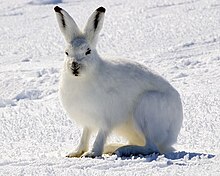Arctic hare
| Arctic hare | |
|---|---|
 |
|
| Arctic hare | |
| Scientific classification | |
| Kingdom: | Animalia |
| Phylum: | Chordata |
| Class: | Mammalia |
| Order: | Lagomorpha |
| Family: | Leporidae |
| Genus: | Lepus |
| Species: | L. arcticus |
| Binomial name | |
|
Lepus arcticus Ross, 1819 |
|
| Subspecies | |
|
4, see text |
|
 |
|
| Arctic hare range | |
4, see text
The Arctic hare (Lepus arcticus), or polar rabbit, is a species of hare which is highly adapted to living in the artic tundra, and other icy biomes. The Arctic hare survives with shortened ears and limbs, a small nose, body fat that makes up 20% of its body, and a thick coat of fur. It usually digs holes in the ground or under snow to keep warm and sleep. Arctic hares look like rabbits but have shorter ears, are taller when standing, and, unlike rabbits, can thrive in extreme cold. They can travel together with many other hares, sometimes huddling with dozens or more, but are usually found alone, taking, in some cases, more than one partner. The Arctic hare can run up to 60 kilometres per hour (40 mph).
Known predators of the Arctic hare are the Arctic fox (Vulpes lagopus), red fox (Vulpes vulpes), gray wolf (Canis lupus), Canada lynx (Lynx canadensis), ermine (Mustela erminea), snowy owl (Bubo scandiacus), gyrfalcon (Falco rusticolus), rough-legged hawk (Buteo lagopus), and humans (Homo sapiens).
The Arctic wolf is probably the most successful predator of the Arctic hare, and even young wolves in their first autumn can catch adult hares. Arctic foxes and ermines, which are smaller, typically prey on young hares. Gyrfalcon carry hares to their nests, cutting them in half first; gyrfalcons use hare bones and feet in the structure of their nests on Ellesmere Island, Nunavut.Peregrine falcons (Falco peregrinus) also prey on Arctic hares in the southern end of the hares' range. The Snowy owls mainly targets young hare; the French common name of the species derives from Anglo-Saxon harfang ("hare-catcher").
Four groups of parasites have been known to use Arctic hares as a host: protozoans (Eimeria exigua, E. magna, E. perforans, and E. sculpta); nematodes (including Filaria and Oxyuris ambigua); lice (including Haemodipsus lyriocephalus and H. setoni) and fleas (including Hoplopsyllus glacialis, Euhoplopsyllus glacialis, and Megabothris groenlandicus. Fleas are more common than parasitic worms.
...
Wikipedia

